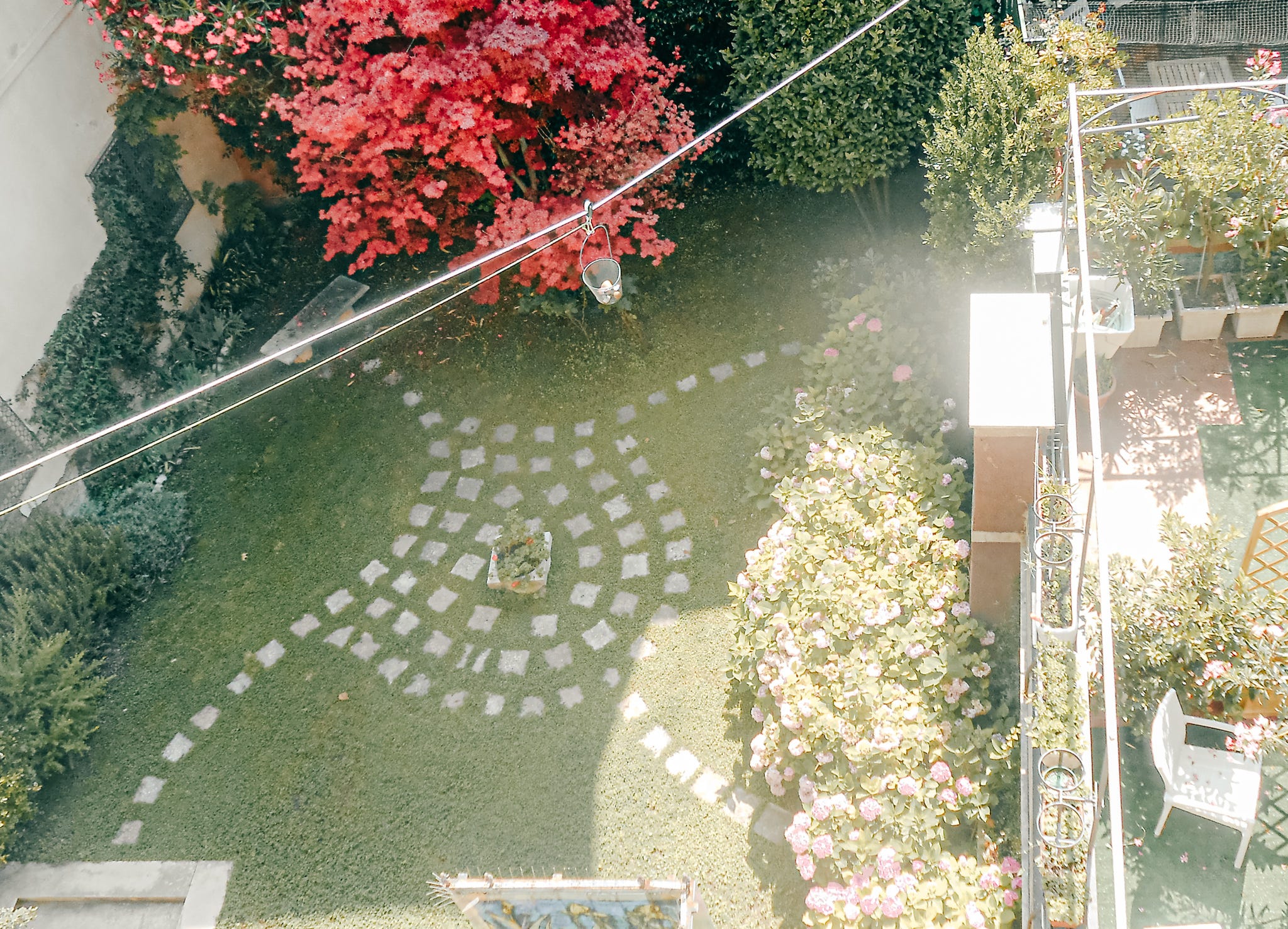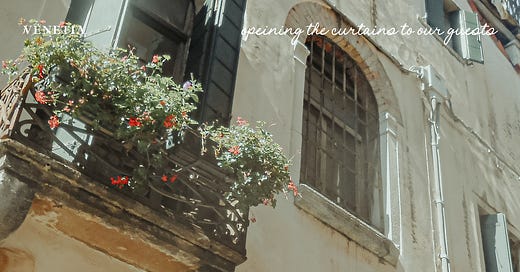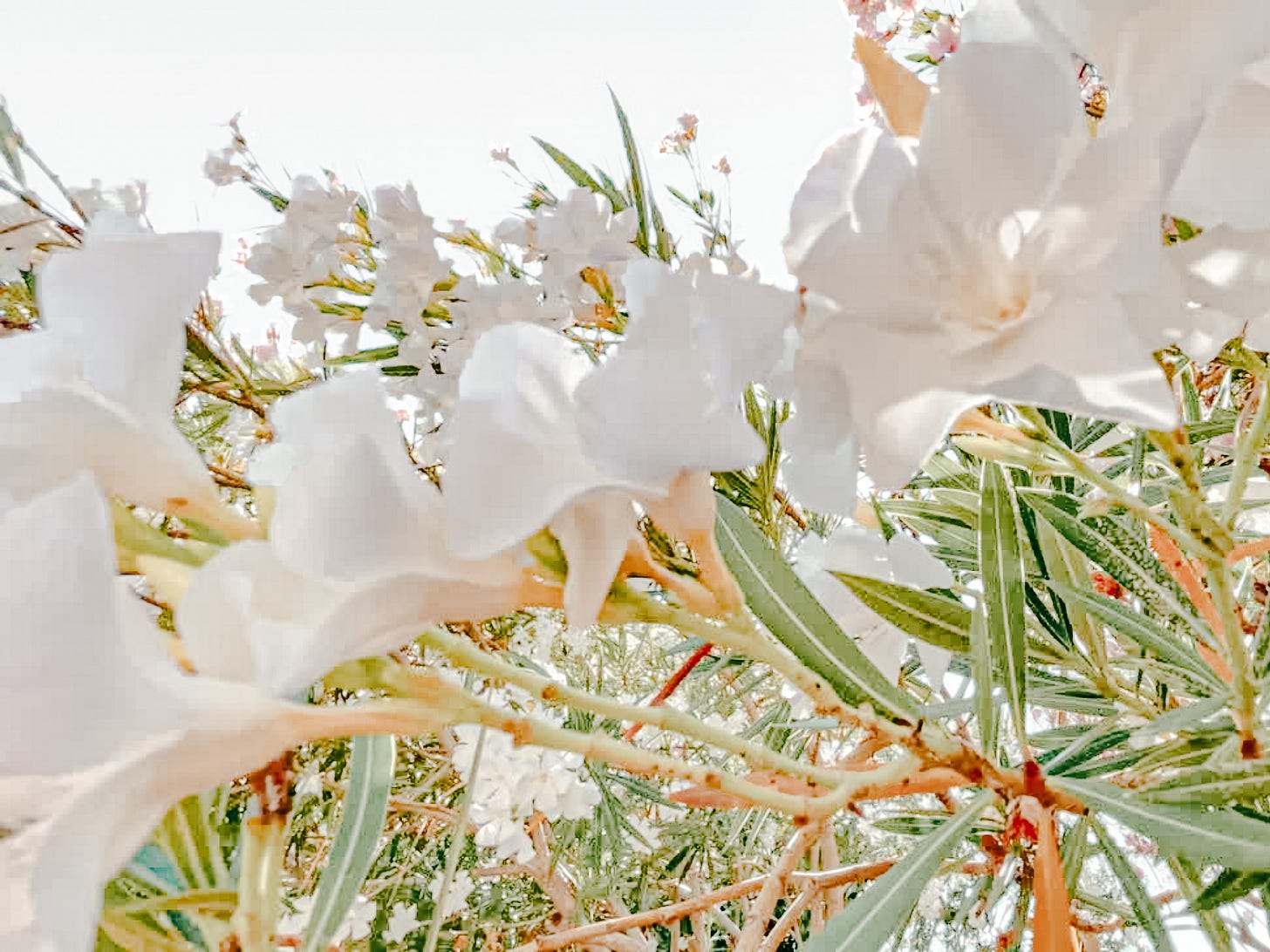The Mystery of the White Oleander
A story about saving Venetian botanical heritage: Oleander plants that looked and smelled so differently. Join us to discover the story of these white beauties in the Lagoon monasteries.
Can you imagine the incredible cloud of oleander blossoms and wisteria (!) in the last week of June, and in early July? Well, until three years ago, you could witness this scenery in Nonna Lina’s garden.
As we’re describing here in the home tour, hers is a hanging garden made up of terraced “garden rooms”, with upper terraces completely exposed to the sun, very strong in early summer.
While from beginning, Nonna has been focusing on growing edible plants in the garden, there’s one white-washed terrace overlooking Campo San Zaccaria on which no other plants are able to survive - not even cacti or agaves! A bright space with desert climate so to say, also because the white paint relentlessy reflects the strong Mediterranean sun. In summer, even as early as 9 am, it’s impossible to sit on one of the stone benches on the one side of this terrace.
Well, white oleanders1 do have a special story to tell, and as they’re beautiful but poisonous, they were given a separate space to live in .. They were here long before Nonna’s family purchased the house from the suore tedesche, as they were called in the neigbhorhood: German nuns who took care of the gardens, as San Zaccaria was the first monastery to be suppressed in 1797 when the French army occupied Venice.

They were lush, white and tall, incredibly hardy, blossoming from late April to mid-October, while creating a thick roof above the terrace. They also smelled heavenly, protecting cacti and agaves from the summer heat.
And they were very old - you could easily notice their age touching their rough and knotty trunks. They were already growing lush before the German nuns had moved into the house on the premises of the former monastery San Zaccaria, in the late 1930s.
These special oleanders lived well until the night of 12 November 2019, when a huge flood caused by three winds out of balance2 hit Venice. In the wake of the floods and heavy storms, Nonna’s garden, almost as low-lying as Piazza San Marco, was severely damaged: Heavy rain and the rising water from the ground turned the garden and its terraces into one muddy scene.
Oleanders are much loved in Venice, and are also the “centerpiece” of an ancient campo nearby, called Campo della Bragora. It’s one of my favorite campi (squares), as there’s also a mimosa albizia (silk tree) and a lush pomegrante tree, and a tiglio (linden tree) as well. Imagine the most beautiful green oasis in the bright morning light of summer solstice!
Fragrant summer blossom trees like these, and the oleanders are used to structure this campo into several “rooms”. Each is used for a topic: Singing, dancing, watching movies, cooking and eating. And when night falls, you’ll feel enveloped by the heavy lemon-vanilla scent coming from the huge white oleander blossoming on the campo. A scent almost as strong as the smell of coffee and grilled fish at the food stall put up for the solstice feast in the corner next to the church, San Giovanni in Bragora.
This oleander plant on Campo della Bragora is also special - often overlooked during daytime, but never while it releases the sweet vanilla scent of its blossoms in the calm morning light or after sunset.
White plants are a rarity in secular Venice, there are almost no “completely white gardens” if you take a closer look around. Occasionally, there are white spots like the wisteria alba growing in secret gardens on the Lido: Amongst them is the tallest white-blossoming wisteria I’ve seen in the Lagoon, whose cascades of blossoms open in the first week of May.
It’s different with the monastery gardens: The color of the (few) ornamental flowers in these gardens is still white. You can also notice it in the gardens of the monastery on Fondamenta Santa Caterina (Cannaregio).
White oleanders are the relics of times long past on ancient monastery grounds like our garden. So for this reason, we feel like these plants connect us to another world, long gone, but one that we’re still longing for to witness and explore, especially in a house like Nonna’s.
As oleanders used to be propagated by hand by the nuns, we can be quite sure that ours were the descendants of the oleanders once growing in the San Zaccaria gardens. They looked and smelled differently from the plants we can purchase at the garden centers (such as Serra dei Giardini) in Venice. As you can see in the images above, the blossoms are double-flowered, slightly ivory, and their smell is so much stronger - like the heavy vanilla-lemon waft I’m describing in this post on the “Paradise garden”.
Sadly, all of these white oleanders died in November 2019, with the exception of five twigs that Nonna was able to save and is now trying to propagate - “work in progress"! So far, two of the young plants have survived, growing slowly but steadily, lovingly protected by the shade of Nonna’s other oleanders, blossoming red and pale pink.
Oleander is a fast-growing but toxic evergreen shrub, that has been around since ancient times, originally from Africa and the shores of the eastern Mediterranean coasts. From there, Venetian merchants brought them to Venice (probably in the 14th century).
Scirocco, bora, libesco were the three winds that seriously endangered Venice on the night of 12 November 2019. Such a disaster used to happen once in a lifetime until the 20th century, when weather conditions cause the flow of the tides to stop working. We’ll have a post on the tides and winds in the Lagoon of Venice here on Laguna in Cucina soon.







A fascinating post - thank you very much for this. I need to come and smell them!